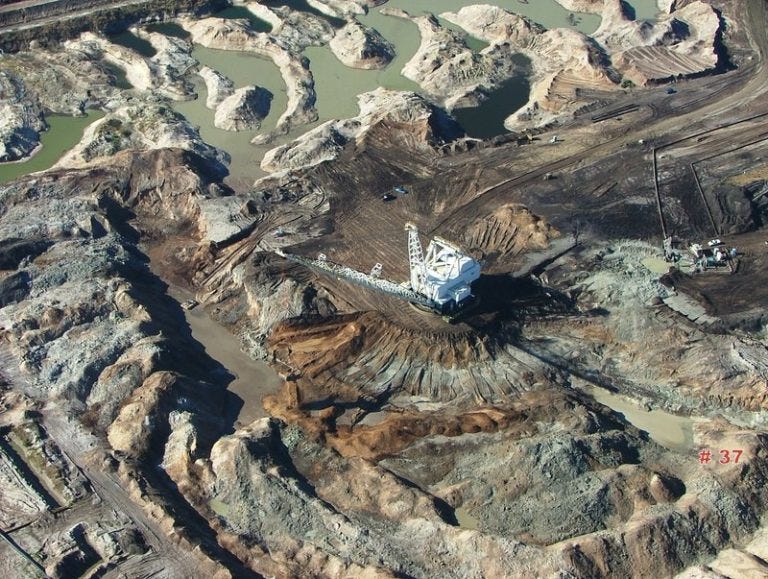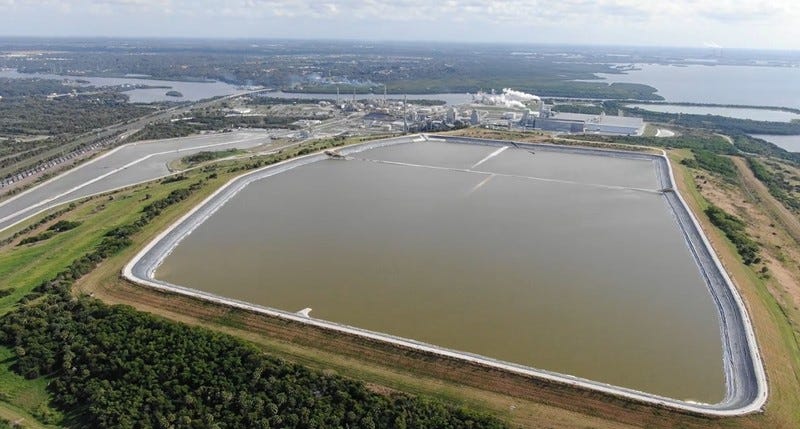Phosphate is as much 'climate mineral' as lithium
It's crucial to agriculture and EV batteries, scarce and concentrated in a few countries, linked to pollution from cradle to grave – why the low profile?
Climate technologies require enormous amounts of metal. I’m Ian Morse, and this is Green Rocks, a newsletter that doesn’t want dirty mining to ruin clean energy.
In the past few decades, Florida’s center has dipped in some places and bulged in others. Most of the peninsula is relatively flat, with wetlands stretching to the horizon where it meets the sky. There are few natural lakes, and rivers lethargically make their way to the Gulf of Mexico or the Atlantic Ocean.
But here in central Florida, 24 mounds stand up to 200 feet high. They can be the highest points in the area. From the air, you can see dozens of still-water lakes in odd, angular polygons. They’re shaped by waste from a century of mining that is picking up steam, spreading across this state, which will see some of the most dramatic effects of climate change in the US.

Florida is the source of most of the US’s phosphate – a critical ingredient for fertilizers for the phosphorus that helps plant growth. In an area larger than Houston, 27 mines produce 80% of the phosphate used in the US, and 25% of the world’s consumption. Mines combine the ore with sulfuric acid to create phosphoric acid, which is shipped off to make fertilizer and animal feed. But the process also generates plentiful amounts of waste, called phosphogypsum. It dries into a crusty gray and remains radioactive for centuries. And companies in Florida are adding 30 million tons to these mounds every year.
Why Green Rocks is dealing with phosphorus:
Phosphate is a primary ingredient in the cathodes of a recent wave of lithium-ion batteries on the market for electric vehicles. Lithium-iron-phosphate batteries have lower energy densities than ones with nickel and cobalt cathodes, but they are cheaper and further from the headline issues that plague nickel and cobalt.
Phosphorus, though, is experiencing its own crisis. The element typically cycles from plant to herbivore to feces, returning to the soil for plants to continue to use. However, most humans get rid of their sewage far from the sites of agriculture. This breaks the cycle and leaves farmers (or farming corporations) to find phosphorus elsewhere, typically from rocks.
But that doesn’t repair the cycle. The phosphorus from mined ore travels through our bellies, into sewage, and back to landfills or the ocean. Mines need to replenish the phosphorus in soil around the world to continue to feed people dependent on industrialized agriculture. Mined phosphates are now 50% of the soil’s natural productivity.
And we’re running out of phosphorus. Given current consumption and known reserves of phosphate, estimates say we could run out within decades. It’s also highly concentrated: more than two-thirds of reserves are in Morocco and Western Sahara, which Morocco claims largely as a result of its wealth of earthen resources (and where a phosphate mine built the longest conveyor belt in the world).
Yet we’re likely to need much more phosphorus as a result of continual degradation of soils and warming temperatures. Producing more food, more quickly, on less land, with machines and private equity, demands more phosphorus. Plants struggle to absorb phosphorus when temperatures fluctuate both up and down, which we are increasingly seeing as climate impacts.
Scientists wrote in Nature last year that phosphate deserves as much attention from clean energy researchers as lithium, cobalt and nickel. They write: “It is essential that LFP phosphorus forecasts be contextualised within the global phosphorus cycle and market to ensure minimal potential conflict between future energy and food systems.”
Phosphate is as much a climate mineral as lithium. Perhaps more so, considering most lithium production funnels to products unconnected to climate goals, and phosphorus is almost entirely produced for agriculture, the source of a quarter of global emissions.
To understand how phosphate enters the world, I spoke with Glenn Compton, who chairs Manasota-88, an environmental nonprofit based in two Florida counties dealing with mining impacts. The mines and mounds are found mainly (and ominously) in Bone Valley.
In 2021, one of the mounds of phosphogypsum waste, called gypstacks, leaked. A couple hundred million gallons of wastewater flowed into Tampa Bay, worsening harmful algae blooms and prompting Governor Ron DeSantis to declare a state of emergency. This year, the same gypstack persuaded the state to allow it to dump more wastewater into the bay.
The gypstacks have caused environmental disasters for decades.
In 2016, a sinkhole opened beneath a stack, draining polluted water underground, and no one knows where it went.
In 2011, a rip in the lining underneath a stack poured more wastewater into Tampa Bay.
In 2004, waves during a tropical storm destroyed the barriers keeping waste on the stacks, sending it into creeks where it killed untold wetland life.
In 2001, a company went bankrupt and left its waste to flow into ditches that fed marine breeding grounds.
In 1997, a dam broke atop a stack, and the wastewater flowed downstream through rivers, killing everything in its path.
Phosphorus from fertilizers and mines end up in the water. Ecosystems that support endangered manatees are upended. Too many nutrients in the water destabilizes the balance between species: algae flourishes and suffocates other plants and animals that need the water’s oxygen. In the Indian Ocean, mining on an island smothered surrounding coral reefs. Impacts extend to humans. Workers at a phosphate facility were found to have a higher incidence of lung cancer and leukemia. Studies this year found elevated risk extended to people who lived nearby mines in Tunisia and Togo.
“Phosphate mining is kind of a cradle-to-grave operation of pollution,” says Compton. “The cradle is the mining impacts and wastewater discharge that happens on site. And the grave is the phosphogypsum. But all along the way you have pollution that gets into the environment, because you're producing a product that is widespread and goes into our waterways: fertilizer that's being used agriculturally and residentially.”
A nearby county that companies have eyed for its reserves banned phosphate mining in January 2022. Another county rejected a mining plan from Mosaic, the world’s largest phosphate company, but the company continues to push it, saying that without its product, “growers won’t be able to produce enough food to feed the world’s growing population.”

Compton says the industry needs to figure out what to with the waste. His volunteer group, Manasota-88, formed in 1968 with the hope that its complaints about phosphate mining would be addressed by 1988. By the early 1970s, activists realized it would take a lot longer. The “88” now refers to a new goal of 2088.
The only solution to the waste issue, so far, is not to produce the phosphogypsum in the first place. Companies have suggested using it as material in roads, but the EPA shut that option down due to its radioactivity. In places where it’s not radioactive, like North Florida, small portions of it can be used as a soil enhancer. Companies have also proposed using it in glass and landfills.
“The industry has had over 70 years to come up with a solution. And they have yet to do that,” Compton says. “The only way that it’s going to happen is that you have to hold the industry's feet to the fire.”
Compton says mines have avoided requirements to preserve wetlands by building a fire station, and they’ve checked the box to restore mines after use by turning them into a golf resort, a mountain biking state park, or a public fishing grounds dug out by mines.
Compton’s Manasota-88 is targeting regulators to force companies to come up with solutions. It was one of more than a dozen groups that petitioned the EPA in 2021 to strengthen its control over phosphate in Florida. Compton urged last December that the EPA undertake a review of the entire phosphate industry. Most power, though, resides within the state, separated across several permits. Manasota-88 is also party to a lawsuit against Florida’s Department of Environment Regulation, alleging that its negligence and mishandling allowed waste to endanger citizens and the environment.
Phosphate doesn’t work like most other “climate minerals.” Companies say they need to boost production of lithium and cobalt for everyone to meet climate goals. Phosphate, in its agricultural role, could benefit the climate if less were to be used. Too much phosphorus can obliterate microbial communities and form compounds that plants can’t use.
“Nowadays I see that fertilisers are helping to degrade [the soil] and not build fertile soils,” a soil scientist Amanda Posselt Martins told Carbon Brief.
Using less doesn’t mean we need to eat less food (or produce fewer EV batteries). There’s plenty of research into the ways to reduce demand and recycle phosphorus. Transcontinental researchers found the biggest step is eating less meat: how much meat we eat can determines how much animal feed needs to be grown and produced from phosphates. We can also process our toilet waste to be used as fertilizer. Some states in the US have begun to encourage this, also they’re coming up against the other pollutants that our waste carries, which can harm soil and ourselves.
Phosphate use has quadrupled in the last 50 years. Much of it can be attributed to the “Green Revolution” which saw western companies pioneer methods to boost production in global South countries. Industrialized agriculture steamrolled more sustainable forms of agriculture, writes professor of biodiversity Alexandre Antonelli in Nature. Fixing things like the phosphorus cycle must also force a reckoning with the destruction wrought by colonialism and the Indigenous knowledge it sought to decimate. He writes:
Today, food production is the biggest driver of biodiversity loss and contributes heavily to climate change and pollution — the three components of the ‘triple planetary crisis’ recognized by the United Nations as requiring resolution if humanity is to create a viable future on this planet. As such, there has never been more need to establish how Indigenous and local knowledge can contribute to the building of resilient, sustainable and nutritious food systems in a way that is equitable.
Read more:
Battle over phosphate mining roils small Fla. town (PBS Newshour)
Environmentalists Target Mountains of Fertilizer Waste (Undark)
Humans are flushing away one of life’s essential elements (The Atlantic)
The World’s Farms Are Hooked on Phosphorus. It’s a Problem (Wired)
Waste Not, Want Not (JSTOR Daily)
What does the world’s reliance on fertilisers mean for climate change? (Carbon Brief)






I've wondered about this, so thanks, Ian, for giving this perspective. Would it be wrong to say that phosphate for EV batteries is a very small part of overall demand/production? Also, phosphate has the potential advantage over nickel and cobalt (for EV batteries) in that a lot of production is in the US. At least we can take responsibility for our own impacts that way, although it sounds like Tunisia and Togo are bearing some risks too. As I recall, the island country of Nauru was pretty much obliterated by phosphate mining.